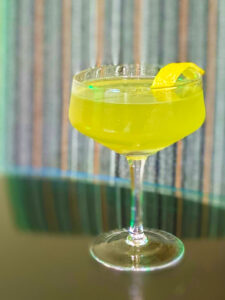The oldest item in our liquor cabinet isn’t a vintage cognac or an antique whiskey. It’s a bottle of blueberry schnapps, about to enter its fourth decade of gathering dust.
We got it not as a drink but as a prop. Chef Sin was playing Jewish grandmother Bubbie in a production of Crossing Delancey, and the script calls for the character to clutch a little bottle of Cherry Heering (“I LOVE Cherry Heering!”). Unable to find an appropriately sized container of the real thing, the director called in an understudy: a small bottle of blueberry schnapps. We inherited the bottle after the show closed.
The fact that we hadn’t found a use for this particular spirit in the ensuing decades is not surprising. Blueberry schnapps is definitely a niche liquid; Adrienne Stillman’s encyclopedic Spirited: Cocktails from Around the World, which gathers 610 recipes from 60 countries spanning 500 years, includes not a single drink containing the spirit. Blueberry schnapps is probably consumed less often in mixed drinks than straight from secret flasks.
And that underscores a problem with the entire category of liqueurs, cordials, and schnapps—specialty spirits, often sweet, distilled or infused with the flavors of fruits, herbs, or nuts. You buy one here and there for a cocktail you’ve been dying to try, and you end up with a cabinet bursting with barely used bottles that don’t seem to ever reach empty.
The solution: make your own liqueurs in small batches. And give most of them away as gifts.
Do-it-yourself liqueurs are surprisingly simple and mostly follow the same general formula regardless of the flavor:
- Place fruit, herbs, or nuts in a glass jar and fill with brandy and/or vodka.
- Store in cool, dark place for one week to two months.
- Strain out solids, add simple syrup, and store again for one week to two months.
- Bottle, share, and enjoy.
Limoncello seems to be the most popular home-made liqueur, with even celebrity chefs offering their own recipes. And no wonder: It’s among the most versatile liqueurs, useful in creating everything from jazzed up Lemon Drops to boozy Arnold Palmers. If you want the full-on lemon effect, I offer my version of the Limoncello Sparkler, which uses neutral vodka to ensure nothing gets in the way of the pucker.
My first foray into the craft liqueur world was a thyme liqueur, also known as liqueur de farigoule. It aged a total of four months, and the resulting potion is aromatic and complex—and tough to match with other spirits such as bourbon or gin. But it’s great with rum, as Greek bartender Konstaninos Kapniaris proved with his award-winning creation, the Thimisis. With all due respect to Kapniaris, though, I think that the half-ounce of farigoule called for in his recipe is really the upper limit; you might try half that to ensure that the thyme flavor doesn’t overpower.
My next liqueur adventure is going to be hazelnut. We’ve got a bottle of Frangelico that’s almost as old as the blueberry schnapps, but I’m betting a home-infused version would be better and more versatile. I’m eager to try it in the simple, sweet dessert drink often called a Hazelnut Martini—but since I frown on all “non-tinis,” I have renamed this drink after another moniker for the hazelnut: the filbert, which may have earned that label from the Old German word for “full beard.” (Hazelnuts on the tree have hairy husks.)
What about blueberry schnapps, that most non-versatile of spirits? As with many liqueurs, the best approach is to employ it to enhance a drink you already love. In our case, we found the addition of blueberry schnapps to a standard Mojito was incredibly delicious.
And finally, there’s Cherry Heering (“I LOVE Cherry Heering!”). Its most popular use is in the fruit-salad-in-a-bar-glass concoction called the Singapore Sling, but many other recipes exist. Unless you want a cocktail that tastes like cough syrup, however, I recommend the Cherry Heering be used sparingly.
And if for some reason you enjoy the taste of cough syrup, mix it 1-to-1 with gin over ice. I’m sure Bubbie would LOVE it.
Limoncello Sparkler
1 ounce limoncello
1 ounce vodka
1 1/2 teaspoons simple syrup
1 teaspoon freshly squeezed lemon juice
Seltzer, chilled
Lemon peel for garnish
Stir limoncello, vodka, simple syrup, and lemon juice with ice until well chilled. Strain into a chilled cocktail glass and top with seltzer. Stir briefly and garnish with lemon peel.
Thimisis
Adapted from Difford’s Guide
1 2/3 ounces light rum
1/2 ounce thyme liqueur
1/2 ounce simple syrup or honey water
2/3 ounce lime juice
2 dashes lavender bitters
Lavender flower for garnish
Add liquid ingredients to shaker with ice and shake until chilled. Strain into chilled cocktail glass. Garnish with a lavender flower.
Full Beard
1 1/3 ounces vodka
1/3 ounce hazelnut liqueur
1/3 ounce white cacao liqueur
Stir ingredients with ice cubes until chilled. Strain into a chilled cocktail glass.
Blueberry Mojito High
Adapted from Complete Cocktails
1 ounce blueberry schnapps
1 ounce white rum
1/2 ounce simple syrup
1/2 ounce fresh lime juice
8 fresh mint leaves
Seltzer
Mint leaves for garnish
Muddle simple syrup, lime juice, and mint leaves in the bottom of a highball glass. Fill with ice, add rum and blueberry schnapps, and stir. Top with seltzer and garnish with mint leaves.
Red Gin
Adapted from Bar None Drinks
2 ounces gin
1 teaspoon Cherry Heering Liqueur
Cherry for garnish

